March 10, 2013
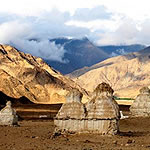 Legend has it that Jesus visited Hemis monastery in the Ladakh region some time between the ages of twelve and thirty, a period of Jesus’ life that we know little about.
Legend has it that Jesus visited Hemis monastery in the Ladakh region some time between the ages of twelve and thirty, a period of Jesus’ life that we know little about.
A Russian journalist called Notovich came to Hemis in the 19th century and was shown a document by the chief lama detailing the story of the life of “Issa”, a name which is close to the Arabic word used in the Koran to refer to Jesus.
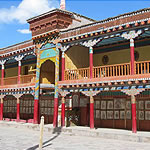 Novotich translated this document which tells of Jesus studying Buddhism. The story was of course deemed heretical and discredited by the church. The original document at the monastery was mysteriously lost, and the tale passed into myth.
Novotich translated this document which tells of Jesus studying Buddhism. The story was of course deemed heretical and discredited by the church. The original document at the monastery was mysteriously lost, and the tale passed into myth.
We were told this story by our expert guide as we cycled along the Indus valley, looking up and ahead to Hemis monastery, the deep red decorations on its facade framed by the stark brown of the hills behind and the snow-capped peaks of the Stok mountain range above.
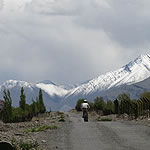 The road up to the monastery looked rather too steep for my unpractised cycling ability, but at the critical moment a support vehicle appeared and I was whisked up to the monastery by motorcar. Whizzing down the mountain with sweeping curves and the green plain unfolding below us was great kiddie fun once we were back on our bikes.
The road up to the monastery looked rather too steep for my unpractised cycling ability, but at the critical moment a support vehicle appeared and I was whisked up to the monastery by motorcar. Whizzing down the mountain with sweeping curves and the green plain unfolding below us was great kiddie fun once we were back on our bikes.
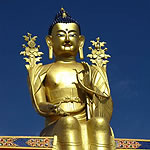 Buddhism certainly dominates the landscape in this remote and at times unreachable part of north-west India. Besides the rich and colourful monasteries and temples you see at every turn stupas containing Buddhist relics, prayer flags fluttering in the wind, mani walls and prayer wheels.
Buddhism certainly dominates the landscape in this remote and at times unreachable part of north-west India. Besides the rich and colourful monasteries and temples you see at every turn stupas containing Buddhist relics, prayer flags fluttering in the wind, mani walls and prayer wheels.
The general tourist market has been coming to Ladakh since the 1970s, but my holiday was an experience totally removed from the mainstream. Jamshyd Sethna, a visionary travel professional, is the man who has created journeys that take you off the beaten track and into the heart of village life.
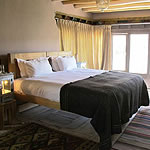 Accommodation is in authentic village houses which have been beautifully refurbished to western standards; they are large enough to house both the families to whom they have belonged for generations and their visitors.
Accommodation is in authentic village houses which have been beautifully refurbished to western standards; they are large enough to house both the families to whom they have belonged for generations and their visitors.
One morning whilst staying in the village of Nyemo I heard lyrical chanting in the family’s prayer room; a little later the owner of the house came in to the sitting room with incense – a symbol of peace and goodwill. It was an unscripted moment in village life which quietly carries on around you. The animals are stalled close by, but their presence is never obtrusive. As a guest you are connected to what is going on rather than being cocooned in boutique luxury. 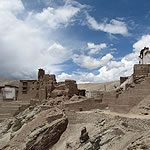 People greet you with an up-beat ‘Julai’ (the Tibetan for hello, amongst other things) and are seemingly totally unfazed by the presence of foreigners in their midst.
People greet you with an up-beat ‘Julai’ (the Tibetan for hello, amongst other things) and are seemingly totally unfazed by the presence of foreigners in their midst.
The six houses are taken on an exclusive basis and not shared with other guests. During a week’s stay you might stay in three or four of them. There are lots of smiling staff who are extremely attentive and prepare really delicious food which is often far better than that to be found in the posh hotels in Delhi.
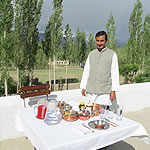 One afternoon we climbed up the pass behind Likhir village. The houses soon thinned out as we traced the course of a stream, the swathe of vibrant green pasture on its bank forming a dramatic contrast to the starker brown mountains on either side. Dzos, a cross between a cow and a yak, were grazing, and a herd of goats was scampering down the path from higher pasture. We saw smoke rising from a low-built stone hut, the summer dwelling of one of the last remaining herdswomen. We were invited in to celebrate the birth that day of a dzo and enjoyed sweet milky tea and Ritz biscuits served on the best china. As we headed back down the valley passing the odd prayer wheel (those visible signs of Buddhism again), the late afternoon
One afternoon we climbed up the pass behind Likhir village. The houses soon thinned out as we traced the course of a stream, the swathe of vibrant green pasture on its bank forming a dramatic contrast to the starker brown mountains on either side. Dzos, a cross between a cow and a yak, were grazing, and a herd of goats was scampering down the path from higher pasture. We saw smoke rising from a low-built stone hut, the summer dwelling of one of the last remaining herdswomen. We were invited in to celebrate the birth that day of a dzo and enjoyed sweet milky tea and Ritz biscuits served on the best china. As we headed back down the valley passing the odd prayer wheel (those visible signs of Buddhism again), the late afternoon 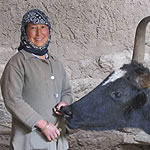 sun glinting on stupas and the huge golden Buddha of Likhir monastery way down below, I thought what welcome sights these must have been to traders on the silk route from yester-year. I also thought how very special it was to explore an extraordinary and sometimes harsh landscape which is softened and complemented by the gentleness and inner calm of the people who live there.
sun glinting on stupas and the huge golden Buddha of Likhir monastery way down below, I thought what welcome sights these must have been to traders on the silk route from yester-year. I also thought how very special it was to explore an extraordinary and sometimes harsh landscape which is softened and complemented by the gentleness and inner calm of the people who live there.
Activities on these journeys include walking (as much or as little as you like), cycling, visits to monasteries, battlefields and forts, cooking lessons, archery and white water rafting. Mobile camping with proper washing facilities may also be added into the mix for those who want to do slightly more serious walking in even remoter locations.
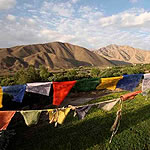 The season for Ladakh is during the summer months from mid-May to the end of September. If this period doesn’t suit we have a similar experience operating in the lower Himalaya areas of Sikkim and Kumaon.
The season for Ladakh is during the summer months from mid-May to the end of September. If this period doesn’t suit we have a similar experience operating in the lower Himalaya areas of Sikkim and Kumaon.
Prices for a week in Ladakh on a fully inclusive basis with a night at either end in Delhi and international flights are from £3,890 per person.
Call Miles Barber on 0207 723 5858 for further information.
NB prices shown were current at the time of writing the newsletter and are not necessarily current now.
Please ask for an updated quote.
- The Khajuraho temple complex, a Unesco World Heritage Site
- A Sense of Place: Poignancy in KwaZulu Natal
- A Sense of Place: Northern Botswana
- A Trio of Treats in India
- And now for something completely off grid and different: AFRICA’S ULTIMATE RAINFOREST SAFARI
- A Trio of Treats off the beaten track – We get you to places that others don’t!
- A Trio of Treats On The Rift Valley
- A Sense of Place – Can the muppets save a species?
- Trio of treats (Rajasthan, Maldives and Garden Route)
- A Sense of Place – A favourite place: Tanzania and Ruaha
- A Sense of Place – A favourite place in Botswana: the Okavango with elephants galore
- A Sense of Place – Here be dragons and a dark past
- A Sense of Place – Justice Regained
- A Sense of Place – Summer rains make the roads impassable
- A Sense of Place – ‘Those two ladies put light in my future.’
- A Sense of Place – The bird who lost its nest
- A Sense of Place – Talking with the Maasai
- Newsflash: first American guests to Tanzania since March 2020
- A Sense of Place – AFRICA NEEDS YOU
- Escape to Italy?
- Covid: the road still to be travelled.
- A trio of treats. Series of 3 (Part 3): Tiger reserves.
- A trio of treats. Series of 3 (Part 2): Khajuraho.
- A trio of treats. Series of 3 (Part 1): Lucknow.
- A Sense of Place – Engaged people may save the planet
- A word on lions and a trio of treats
- A Sense of Place – India’s most holy city
- A wealth of wilderness walks in Namibia
- Travel snippets from Miles
- A trio of treats on the green island of Pemba in the Zanzibar archipelago
- A Sense of Place – THE INSIDE TRACK on Cape Town guiding
- A Sense of Place – Migrations of people and beasts: East Africa
- A Sense of Place – An era of revolution and global alliances
- A Sense of Place – A walk on the wild side
- A Sense of Place – The ghost ingredient is back
- A Sense of Place – Liuwa Plains and Kafue National Parks – Zambia
- A Sense of Place – Literati in the Pink City, the Capital of Rajasthan
- A Sense of Place – A Tamil town still connected to Europe, Art Deco architecture, and temple antiquity in Southern India.
- A Sense of Place – Dreamy aquamarine sea and stunning safari with the Makuleke people
- A Sense of Place – A trio of lovely ladies in Hyderabad
- A Sense of Place – Entamanu, the wishing tree and walking with the Hadza tribe.
- We get you to places that others don’t… St Helena, Gt Zimbabwe ruins and Papua new Guinea
- A Sense of Place – Walking in the hippie hills of the Himalayas
- A Sense of Place – The Okavango: the river that never finds the sea
- A Sense of Place – The Great Rift Valley, Laikipia, Samburu warriors and Maasai Olympics.
- A Sense of Place – Escape the world in the Namib Desert
- Africa is a massive continent: a collection of 55 countries
- A Sense of Place – Zambezi Watery Wilderness
- A Sense of Place – Burma: the road beyond Mandalay
- Lake Malawi – Would you rather pay for the advertising or the experience?
- From shoe-shine boy to tourist guide in Ethiopia
- A Sense of Place – Ladakh, the Himalayas
- Dhow sailing, Lions are back in Malawi, Self-drive in Namibia
- Sacred rivers and forts, India
- Piranhas, sting rays, caimans – and still people go into the River Negro!
- Kerala, Southern India – God’s own country
- South Africa: Crucible of the rainbow nation
- Madagascar: croissants and lemurs
- Argentina vs Africa on wildlife drama
- Uganda – Gorillas and Gardens
- Mozambique & Kenya: immigration official on holiday
- Mozambique: Gorongosa and reconciliation in the bush
- Zimbabwe is ready for Tourists again
- Serengeti ecosystem and unbeatable savannah
- Lamu: crab complaining
- Kenya: circumcision
- Zambia: Ellie rescue
- Africans: always smiling
- Tswalu
- French sketch
- Kenya: the best hosts
- First visit to Africa 1986
- Namibia, Namib Rand, Skeleton Coast and the ultimate flying safari
- A few gems off the beaten track: Fanjove Island, Tanzania; The Singular Hotel, Patagonia and Isla Palenque, Panama.
- Elephant relocation, quad bike expedition and new Sossusvlei reserve
- Templed out in Tamil Nadu and elephant refuge in Jaipur
- Kenyan sanctuary and family run camp in Zambia
- Australia: Arkaba, Tasmania and Lord Howe Island
- Australia: in the outback and off the beaten track
- India: heavenly Himalayan hideaways, Botswana: fun safari for children and Argentina: hidden homestay in a mountain desert
- Limpopo retreat, Serengeti spectacle and adventure on the Zambezi
- Value for money in Kenya and the trail less travelled in Peru
- Lions in danger, free nights and a new coastal gem
- G and T on demand, hidden beach, micro-light and sleeping on a dam
- Off the beaten track